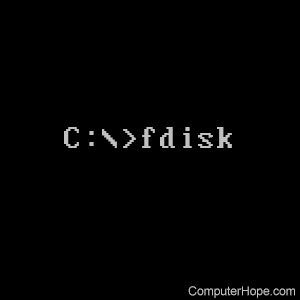Fdisk command

The fdisk command creates and deletes partitions on the hard drive in earlier versions of MS-DOS and Windows.
Availability
Fdisk is an external command that is available for the following Microsoft operating systems. With MS-DOS 3.3x and below, fdisk.com was used as the external file. MS-DOS 4.x and later including versions of Windows that support the command, use fdisk.exe as the external file.
Fdisk syntax
Configures a hard disk for use with MS-DOS.
FDISK [/STATUS] /X
| /STATUS | Displays partition information. |
| /X | Ignores extended disk-access support (will not use LBA support). Use this switch if you receive one of the below symptoms.
Unable to access a drive from DOS versions that predate version 7. |
Secret fdisk switches
Below is a listing of secret or undocumented MS-DOS fdisk commands and switches. Use these commands at your risk.
| Command | Information |
|---|---|
| FDISK /MBR | Command used to rewrite the master boot record, see: Do you have additional information on fdisk /mbr? |
| FDISK /CMBR <DISK> | Recreates the master boot record on the specified disk. Performs the same functions as FDISK /MBR except can be used on other disk drives. |
| FDISK 1/PRI:100 | Creates a 100 MB DOS partition on the hard drive. |
| FDISK 1/EXT:500 | Creates a 500 MB meg extended DOS partition on the hard drive. |
| FDISK 1/LOG:250 | Creates a 250 MB logical drives on the hard drive. |
| FDISK /Q | Prevents fdisk from booting the system automatically after exiting fdisk. |
| FDISK /STATUS | Shows you the current status of your hard drives. |
| FDISK /ACTOK | Makes fdisk not check the disk integrity allowing the drives to be created faster. |
| FDISK /FPRMT | Prevent the prompt for FAT32 support and allows FDISK to be forced into using FAT32 on drives smaller than 540 MB. By default, FDISK does not use FAT32 on any drive smaller than 540 MB. Finally, this command can only be used with FDISK that supports FAT32. |
Fdisk examples
fdisk
Opens the fdisk option screen seen in the fdisk simulation.
If any partition is deleted, everything in that partition is erased.
See the fdisk simulation for additional information and examples.
Additional information
Fdisk script file - Fdisk can run from an external file, allowing you to quickly create and delete partitions. To do this, create a file using the DOS edit command. Below are the steps required for generating said file.
Edit fdisk.scr - In the edit screen, enter the commands you want to run in fdisk. For example, to run fdisk and display the partition information, you would enter 4.
Because fdisk requires you to press Enter after a selection, press Ctrl+P and then Ctrl+M to create a music symbol, which acts as a carriage return.
If you need to press Esc, you would use Ctrl+P then Esc, which would be represented as a backward arrow.
When you input commands to run FDISK, they must be on one line; do not place each command on separate lines.
Once you have created the script file, type fdisk < fdisk.scr to execute the script file. If the script file encounters an error during its process, you need to recreate the script file where the mistake occurred.
Technical support
- Why am I unable to see the full amount of a hard drive?
- Why am I only able to see a 2 gigabyte partition or drive?
- Do you have additional information on fdisk /mbr?
- How to fix a partition showing up as an MS-DOS partition.
- How to fix an invalid or Non-System disk error.
- How to fix Invalid Media type reading drive C:.
- How to fix a no fixed disk present error.
- How to delete a partition using fdisk.
- How to create a partition using fdisk.
- How to lock or unlock the hard drive.
- Error reading or writing fixed disk.
- How many partitions can DOS and Windows recognize?
- How to create a FAT32 partition.
- If your question is not listed here, try our computer help forum.
